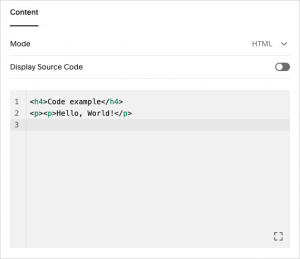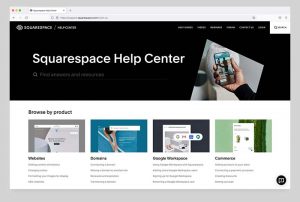

Table of Contents
- What is Squarespace? And how many people use it?
- How does Squarespace work?
- Squarespace plans and pricing
- While you’re here… have you seen our Squarespace video review?
- E-commerce features
- Exchange expenses
- Outsider mixes
- Buying a domain name with Squarespace
- Squarespace templates and design features
- Stock images in Squarespace
- How do Squarespace websites look on a mobile?
- Editing the template design
- Customizing your Squarespace template
- Designing logos with Squarespace
- Content management in Squarespace
- Squarespace-Zapier integration
- Squarespace plugins
- A way to save money on Squarespace
- HTML — adding widgets and code blocks
- How good is Squarespace SEO?
- Ecommerce in Squarespace
- Squarespace’s new member areas feature
- Ease-of-use
- Squarespace review FAQ
In this Squarespace review, I look at all the key pros and cons of one of the best-known website builders available. Is Squarespace right for your web design project — or should you use an alternative platform?
Let’s find out.
In this in-depth look at Squarespace, I’m going to give you:
- an overview of what Squarespace is, and how it works
- an evaluation of its templates and key features
- a list of all the main pros and cons of Squarespace
- a good idea of the best Squarespace plan for you
- a list of the best alternative website builders
By the end of the review, you’ll have a much clearer idea as to whether the platform is right for you.
But first…
What is Squarespace? And how many people use it?
Squarespace is a website builder tool that is aimed mainly at small business owners and ‘solopreneurs.’
Established in 2004 as an answer for let individuals without web improvement abilities fabricate and deal with their own site, Squarespace presently drives a great many sites around the world.
In spite of the fact that it at first began life as a device for building static, leaflet style sites, Squarespace has developed over ongoing years into a stage that currently offers worked in online business and showcasing highlights.
As you’ll see later on in this survey, the stage can now be utilized to have a web-based store, run email showcasing efforts and even assist you with making video promotions.
Web measurement organization Builtwith.com gauges that there is a sum of 2.9 million live Squarespace destinations, making the stage quite possibly the most famous web designer presently accessible. Around 1,150 individuals work for the organization.
How does Squarespace work?
Squarespace is a ‘hosted’ solution. This means that it runs on its own servers and you don’t have to install software on your own computer to use it.
It lets you create a website in a web browser without coding, and edit it easily thanks to a user-friendly content management system (CMS).
All in all, as opposed to stacking Dreamweaver or a comparative website architecture bundle and producing lines of code to build a webpage, you do it all web based utilizing Squarespace’s formats and style manager. All you want to fabricate and keep up with your webpage is admittance to an internet browser and the web.
You pick a format, click on the pieces of the plan you need to change, and afterward change regulators in the style proofreader to transform them.
For instance, you can tap on some text and apply another typeface; click on a foundation and change its tone, etc.
Yet, as a rule, Squarespace isn’t exactly a web designer that is intended for the people who need to alter their plan widely — a stage urges you to pick a layout, make a couple of configuration changes, add some satisfied and hit the ‘go’ button.
Squarespace is a ‘product as a help’ (SaaS) device — this implies that you don’t possess a duplicate of the item, however rather pay a month to month expense to utilize it.
Also, talking about expenses…
Squarespace plans and pricing
There are four Squarespace plans available:
- Personal — $19 per month
- Business — $33 per month
- Basic Commerce — $36 per month
- Advanced Commerce — $65 per month
If you pay upfront for a year, discounts of 25% to 30% are applied to the above fees, depending on the plan.
Additionally, there’s an ‘Enterprise’ plan available. This gives you access to priority support and ‘white glove’ consultancy services to help you create and manage a website; pricing for this is negotiable and based on your requirements.
If you’d like to try Squarespace out before buying, a two-week trial is available, which you can access here.
While you’re here… have you seen our Squarespace video review?
Key differences between the Squarespace plans
When it comes to the key differences between Squarespace pricing plans, some of the main things to look out for are:
E-commerce features
The ‘Individual’ Squarespace plan is the one in particular which doesn’t permit you to sell on the web — web based business usefulness isn’t given on this arrangement by any stretch of the imagination.
The wide range of various plans permit you to sell a limitless number of items on your web-based store — yet the trade usefulness you get relies upon the arrangement.
For instance, a key web based business highlight, deserted truck saving — an approach to recognizing and consequently messaging clients who put things in their trucks yet don’t finish a buy — is just accessible on the most costly arrangement, ‘High level Commerce.’
Other significant internet based store highlights, including progressed limits, memberships, continuous transportation rates and admittance to the Squarespace API are confined to the ‘High level Commerce’ plan as well.
Exchange expenses
You can stay away from exchange expenses on the ‘Essential Commerce’ and ‘High level Commerce’ plans. In the event that you settle on the ‘Field-tested strategy; nonetheless, Squarespace will take a 3% cut of the multitude of exchanges made by means of your web-based store.
Contingent upon the volume of deals included, this might make the ‘Fundamental Commerce’ or ‘High level Commerce’ designs more practical than the ‘Business’ one rapidly.
Whether you can add CSS and contents to your site
The ‘Individual’ Squarespace plan doesn’t allow you to style your site with your own CSS.
CSS is the code used to style a layout — and it tends to be valuable to approach this if you have any desire to have 100 percent command over the plan of your site.
The ‘Individual’ plan likewise keeps you from adding JavaScript to the header of your site. Doing so is many times essential for incorporating other applications and administrations with your site, or adding custom tailored highlights.
The quantity of site patrons you can have
The ‘Individual’ plan confines the quantity of supporters of your site to 2 (there’s no cap on givers on different plans).
Outsider mixes
You can utilize Squarespace’s ‘top notch blocks and combinations’ on the off chance that you’re on a ‘Strategy’ or higher. These permit you to interface your site to outsider applications and administrations like Opentable, Amazon and Mailchimp.
The Squarespace Video Studio application
The Squarespace Video Studio application is another item from Squarespace which intends to assist you with making recordings that match the plan and marking of your site. On the Personal arrangement, you get restricted admittance to this — you can utilize four video formats as opposed to the entire reach.
(I discuss the Video Maker app in more depth later on in the review).
Promotional pop-ups / mobile information bars
On the $33 per month ‘Business’ plan or higher you can use Squarespace’s promotional pop-ups and banners. These allow you to highlight particular offers on your website, or ask users to sign up to mailing lists.
You can also add ‘mobile information bars’ on these plans (pictured below). These make it easier for mobile users to call, email or locate your business quickly.
Buying a domain name with Squarespace
To incentivize you to pay upfront for a year’s service, Squarespace gives anyone taking out an annual plan a free domain name for their first year of using the platform. This means that you can avail of your own custom domain name, www.yoursite.com etc., and connect it easily to your Squarespace site.
Not every custom domain is catered for — several extensions will only be available with a dedicated domain name provider, but the main ones (.com, .net, .info etc.) are catered for, as are some country extensions.
The only thing to remember here is that by using Squarespace to purchase your domain name, you are entrusting both your website AND domain to one company — i.e., if you ever lost access to your Squarespace account, you’d lose access to your domain name too. So, from a security point of view, some users may prefer to avoid doing this.
Now that we’ve looked at some of the key differences between pricing plans, it’s time to take a look at a particularly important aspect of Squarespace: the visuals.
Squarespace templates and design features
Quality of templates
You can choose from around 140 Squarespace templates; all are very attractive and have a slick, contemporary look and feel — in my view outclassing the offering from many other similar hosted website building tools.
In terms of how this selection stacks up against the free template offering from other website builders, it makes Squarespace more generous than Shopify or BigCommerce (which both only offer a few free templates), but less generous than Wix (which offers 800+) and WordPress (for which thousands are available).
One thing I’d say about Squarespace templates is that the majority of them work best if professional, eye-catching photography is used.
So, if you are considering using Squarespace, it makes sense to invest some thought and time in getting some great pictures for your site before you start building it.
And speaking of which…
Stock images in Squarespace
A really nice thing about Squarespace is that it provides you with access to all of Unsplash’s image library out of the box — meaning that you get access to a large number of royalty free images that you can add directly and easily to your website.
When adding an image to a page, you just click a ‘search for image’ option and you can choose a picture from Unsplash to insert into it.
And, if the quality of the Unsplash library doesn’t appeal, Squarespace offers you the option to buy images directly from Getty — these images cost $10 each, which is not unreasonable.
As with the Unsplash integration, it’s very easy to insert Getty images into a Squarespace site — it’s simply a case of searching for a stock image using a keyword, trying it out and paying for the picture if you think it works in context.
I’ve found both the Unsplash and Getty options extremely useful when building Squarespace websites for clients who don’t have any images to hand.
In some cases, the stock photography feature has contributed positively to the overall corporate design of my clients’ sites — and has been particularly helpful when a client has not given any thought to the branding or imagery end of things at all (something that happens rather more than I’d like!).
How do Squarespace websites look on a mobile?
All Squarespace templates are fully responsive, meaning that your site design will adjust itself automatically so that it appears correctly on tablets, mobile devices and desktop computers.
Not only does this make your site more accessible to a wider range of users, it can provide some SEO benefits too.
Additionally, you can enable AMP — Accelerated Mobile Pages — on Squarespace websites. AMP is a Google-backed project which aims to speed up the delivery of content on mobile devices through the use of stripped down code. Using it can provide some user experience and SEO benefits.
Enabling AMP in Squarespace is extremely easy — it’s just a case of ticking a box in your site settings — but it’s important to note that currently, you can only use it with blog posts.
It would be better however if you could enable AMP for products too; this is something you can do with competing products Shopify (via an add-on app) and BigCommerce (out of the box).
Editing the template design
It’s generally easy to configure a Squarespace template design to your liking. You can use a menu of styling options on the right hand side of the screen to adjust how components — displayed on the left — appear.
You can adjust things like fonts, colors, website width and so on with a minimum of fuss.
One important thing worth noting about the latest version of Squarespace (7.1) is that it doesn’t allow you to switch templates once you’ve selected one.
This is frustrating — but less of a big deal than it sounds at first, as all the 7.1 templates work the same way, and you can achieve the same look and feel as another template by tweaking your site fonts and colors.
However, it would definitely be better if Squarespace offered the option to switch to another template design with the click of a button — as many competing platforms do — rather than forcing users to manually change a load of settings.
Customizing your Squarespace template
So long as you’re on a ‘Business’ or higher plan, you can add your own custom CSS to your website — code that allows you to change the appearance of it. This is useful when you want to make a change to your website’s appearance that Squarespace’s design controls don’t really permit.
You won’t be able to see the full CSS stylesheet in Squarespace, but you can add your own CSS rules to change the appearance of certain items on your website.
However, it’s important to note that if you add your own CSS, Squarespace’s customer support team reserves the right to limit the kind of support they give you.
Some competing products are better than Squarespace when it comes to providing full control over the templates — Shopify and BigCommerce, for example, provide you with complete access to your site’s CSS and HTML on all plans.
Designing logos with Squarespace
A useful feature included with Squarespace is a logo designing app.
A selection of symbols and typefaces are provided in the app which you can use to create your logo.
You drop your text and symbols onto a grid, move things about a bit and, when you’re happy with the results, you can download a hi-res version of your logo which can be used either on your site or on printed material.
It’s pretty basic, so won’t be right for all users, but it has its uses. The main thing I’d like to see added to it are more typefaces — the selection available is very limited, especially by comparison to Squarespace’s main site builder.
(This font shortage makes it hard to find a logo that matches any existing brand assets you may have, or a Squarespace template that you’ve picked).
Content management in Squarespace
There is a LOT to like about Squarespace’s approach to content management. Let’s go through some of the good stuff first.
Content sections
Squarespace’s ‘layout engine’ is very straightforward to use and lets you drag and drop ‘content sections’ anywhere on your site easily (images, text, forms, videos, code snippets etc.). This makes for very flexible, attractive presentation of content.
When you set up a page, you can choose from a range of pre-defined page layouts — for example contact pages, about pages, team pages etc. — which can further speed things up.
These are extremely helpful to website-building novices who are not terribly familiar with the best ways to lay out content.
Once you’ve got your page, you can add ‘content sections’ to it. These include:
- text
- images
- audio
- galleries (in slideshow, grid, carousel, or stack format)
- restaurant menus
- event listings
- content summaries
- calendars
- maps
- code
- markdown
…and that’s just a few examples really.
It’s also really easy to change the position of your content sections; it’s simply a case of grabbing an element and dragging it to another location on the page.
It’s easy to place elements within content sections too — you just add ‘content blocks’ (pictured below). As with Squarespace’s content sections, these can be positioned around the page easily.
All in all, the Squarespace content management system is excellent, gives you a great range of design options. It’s one of the strongest arguments for using Squarespace over a competing platform.
(Interestingly, WordPress — one of the main alternatives to Squarespace — recently introduced a new drag and drop editor, Gutenberg, that bears more than a passing resemblance to Squarespace’s drag-and-drop builder. This in my view speaks to its quality).
Squarespace-Zapier integration
If a built-in integration or extension isn’t available to help you get Squarespace talking to a particular app, then you might find the Squarespace-Zapier integration a good option.
This allows you to send data captured via forms in Squarespace to a wide range of third party applications. Zapier is an ‘if this, then that’ (IFTT) tool that allows you to create rules as to what should happen with data from one application when it’s sent to another.
You will usually need a premium Zapier plan to get the most out of this, though ($29.99 per month), and will need to be on a ‘Business’ plan or higher to make use of the integration.
Squarespace plugins
There’s additionally the choice of purchasing ‘code bits’ to improve the usefulness of your Squarespace site from different suppliers.
These pieces are progressively alluded to as ‘Squarespace modules’ — and albeit these additional items are not exactly as simple to introduce as their WordPress reciprocals, they in any case permit you to altogether expand the usefulness of your Squarespace site.
Modules exist for an assortment of utilizations — for instance, improving video foundations, adding sidebars, making custom tailored lightboxes… and much else other than.
Combination with virtual entertainment
Associating Squarespace to online entertainment accounts is extremely direct — you just add your records in your site settings, and Squarespace deals with the significant symbols and feeds (pushing content consequently to chosen informal organizations whenever mentioned).
Every one of the most well known web-based entertainment networks are provided food for in Squarespace, including Facebook, Twitter, LinkedIn and Instagram.
A way to save money on Squarespace
Assuming you’re keen on utilizing Squarespace, the organization is presently offering 10% off its arrangements. This can add up to a seriously saving, particularly in the event that you settle on one of its ‘trade’ plans.
For an additional a month to month charge, you can do email advertising with Squarespace, because of its ‘Email Campaigns’ component. This permits you to catch email addresses and send bulletins to mailing list supporters without leaving the Squarespace climate.
This aligns Squarespace with key contender Wix, which has offered this kind of usefulness for quite a while, through its ‘Rise’ include.
Squarespace offers you four email advertising estimating plans:
Starter — $7 each month to send up to 3 e-bulletins and 500 messages each month
Center — $14 each month for 5 e-pamphlets/5,000 messages
Master — $34 each month for 20 e-pamphlets/50,000 messages
Max — $68 each month for a limitless number of bulletins/250,000 messages
(Similarly as with the ordinary Squarespace plans, these rates are decreased in the event that you pay for Squarespace Email Campaigns on a yearly premise).
In terms of how this pricing stacks up against other email marketing products, the Starter and Core plans are cheap by comparison to the entry-level plans available from the likes of AWeber and Mailchimp; they allow you to start capturing data and creating newsletters without spending too much.
In fact, you can technically host an unlimited number of email addresses with Squarespace Email campaigns, which is very generous.
Another important benefit of using Squarespace’s Email Campaigns is that you can manage your website AND mailing list — probably the two most important online assets of any business — in one place, and keep the branding reasonably consistent across both.
On top of that, the email templates — as you’d expect from Squarespace — are very attractive and mobile-friendly. They are easy to edit too, as the Email Campaigns feature provides a drag-and-drop user interface that is quite similar to Squarespace’s web page editor.
Some autoresponder usefulness is likewise included with Email Campaigns (inasmuch as you are on a ‘Center’ plan or higher). In any case, the mechanization gave is as of now exceptionally essential by correlation with that given by devoted email showcasing apparatuses like Mailchimp or GetResponse, allowing you to make straightforward ‘trickle’ crusades as it were.
Moreover, you can’t section information utilizing custom fields or split test your mailouts utilizing Squarespace Email Campaigns. So ‘power clients’ of email showcasing requiring more refined choices will likely good utilizing another email advertising arrangement.
Editing HTML and CSS on a Squarespace website
HTML — adding widgets and code blocks
Unlike competing platforms like WordPress or Shopify, in Squarespace you can’t really toggle between a WYSIWYG (‘what you see is what you get’) editor and HTML mode on pages and posts.
It is, however, possible to add ‘HTML code blocks’ to a Squarespace website, so you can incorporate a third-party form / widget etc. into proceedings easily.
CSS — styling your website
You can add custom CSS to your Squarespace website (if you’re on the ‘Business’ plan or higher), but it’s not entirely encouraged: you are warned when doing so that 1) adding lines of CSS can break your design, and 2) you might not be able to avail of full support if you add CSS.
That said, if you know what you’re doing with CSS, the freedom to add bespoke visual improvements to your site is definitely welcome.
How good is Squarespace SEO?
Like any facilitated arrangement, you don’t have full admittance to the inward operations of the Squarespace stage or the capacity to pick a super-quick host for your site. Thus, most would agree that there will continuously be a few impediments around SEO with Squarespace.
All things considered, sites worked with Squarespace truly do a considerable amount of things that Google and other web crawlers like:
Nonetheless, Squarespace locales could stack a piece quicker (page speed is significant for SEO). The scores you get utilizing Google’s PageSpeed Insights apparatus for Squarespace locales will generally be really unremarkable.
Note: in the event that you’re keen on figuring out more about upgrading your Squarespace site for a web crawler, do look at our Squarespace SEO asset. What’s more, remember that underlying SEO highlights are just a single piece of the image with regards to SEO; you’ll have to ponder catchphrase research instruments as well.
Ecommerce in Squarespace
The ecommerce functionality in Squarespace is pretty strong. It’s easy to create, edit and manage products and product catalogues. You can definitely create an attractive online store with the platform — and one that’s easy to manage.
Key features include
- an easy to use shopping basket framework
- the capacity to sell a limitless number of items
- the capacity to sell actual products, advanced merchandise, administrations and memberships
- a 0% exchange charge (on ‘Business’ plans)
- programmed deserted truck recuperation (on ‘Trade Advanced’ plan)
- gift vouchers and rebate codes
- client accounts (‘Commerce’ designs as it were)
- retail location usefulness (US as it were).
I especially like the manner in which Squarespace handles item pictures. Not at all like some contending stages, Squarespace permits you to consequently apply picture proportions to every one of the items in your web-based store — an enormous life hack for bigger online business projects.
It merits hailing up the membership usefulness as one more solid element of Squarespace — the stage makes it truly simple for you to acknowledge repeating installments for labor and products.
An interesting aspect of Squarespace ecommerce is its new member areas feature. This lets you charge users for access to a private area of your website, allowing you to sell courses, video and other exclusive content to your audience.
Although this requires an additional fee — ranging from $9 to $40 per month depending on how many member areas you want to set up, or hours of video you’d like to sell — the feature does potentially give you a great way to monetize your website and site traffic.
The video below contains an overview of how member areas can be used.
Squarespace’s new member areas feature
You can try Squarespace for free here (use PARTNER10 code to avail of 10% discount).
There are a few areas in the ecommerce department where Squarespace definitely needs some improvement, however.
Merchants who have more advanced requirements however would be better off looking at a more dedicated e-commerce platform like BigCommerce or Shopify.
Ease-of-use
Squarespace is a very user-friendly product.
In fact, I’ve yet to use a hosted website building platform with an interface that feels quite as slick and as straightforward to use as Squarespace‘s.
Whenever I build a website in Squarespace and hand it over to a client for them to edit themselves, there are rarely any problems — we are not talking about a steep learning curve here at all.
Customer support
Squarespace gives client service by means of email or live talk just — no telephone support is accessible.
As far as the client care that is accessible, while the staff on Squarespace’s help work area are cordial and give sensibly fast solutions to questions (with the live visit choice being speediest), they will more often than not just arrangement with pretty straightforward issues.
Generally, if you need to add some usefulness or plan angles to your Squarespace site that are not given ‘out of the crate’ you will not be guaranteed to get a lot of help from Squarespace.
At times you will be informed that what you are attempting to accomplish is preposterous (regardless of whether really, with a touch of diligence, examination or basic coding it truly IS) and coordinated to peruse the Squarespace blog week after week in the event that the usefulness you’re attempting to add to your site gets added as an authority highlight down the line.
What’s more, as referenced momentarily above, on the off chance that you add custom CSS to your site, you will most likely be unable to get full help from Squarespace.
The assistance community is an accessible web-based manual/information base containing recordings and articles to assist you with understanding how Squarespace functions.
Squarespace review FAQ
Is Squarespace good for beginners?
In general, yes. Squarespace is a ‘do it yourself’ website builder, which means that it’s aimed at people without coding or web design skills. Like all similar products, there is learning curve involved, but of the website builders we’ve tested, it’s definitely one of the easiest to use.
What are the main pros and cons of Squarespace?
The principal benefits of utilizing Squarespace are its lovely formats; its natural point of interaction; its not difficult to-utilize selling instruments and its absence of exchange charges. The principal drawbacks are the way that it doesn’t work with multi-money selling; its absence of update history includes; and its insufficient way to deal with giving GDRP-agreeable treat pennants.
Which is better, Squarespace 7.0 or 7.1?
Despite the fact that Squarespace 7.0 contains a couple of highlights not viewed as in 7.1 (key ones being parallax looking over, greeting pages and the capacity to switch layouts), overall Squarespace 7.1 is the better choice, since you can make quicker destinations with it, it contains better web based business elements and the form will be created and upheld by Squarespace in the long haul.
Is there a free preliminary accessible from Squarespace?
Indeed. You can attempt the item free for 14 days. In the event many more than one that time you haven’t exactly wrapped up building your site, you can profit of a 7-day expansion to this preliminary.
Are there any limits accessible for Squarespace?
Yes. By paying upfront for a year, you can avail of a 25%-30% discount (depending on plan). You can also avail of an additional 10% discount by starting a free trial and entering the PARTNER10 code when upgrading to a paid plan.





















